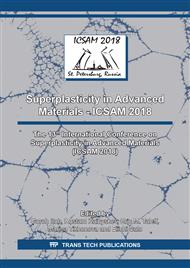p.241
p.245
p.250
p.256
p.262
p.267
p.273
p.278
p.284
Evaluation of Wear Resistance of Copper at Sliding against TiC Based Coatings under Load
Abstract:
An evaluation of the adhesion interaction of copper and TiC-based coatings formed by electrospark deposition using TiC based electrodes (SHIM mark) was carried out. Tribological tests of the samples were carried out using Pin-on-Disk testing machine. It is established that the least (0.07) coefficient of friction has a electrospark coating deposited of electrode material contained tungsten additives. After tests on the optical profilometer, it was found out that some coatings do not have adherence of the wear products of the copper counterbody. So, it was found two different types of interaction of the copper counterbody with the coatings - with adherence and without adherence (so called wear less sliding behavior) which is perspective to develop novel deforming tools.
Info:
Periodical:
Pages:
262-266
Citation:
Online since:
July 2018
Authors:
Price:
Сopyright:
© 2018 Trans Tech Publications Ltd. All Rights Reserved
Share:
Citation:


